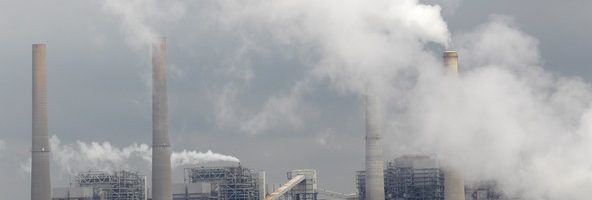Climate change disrupts the power generation industry. How will NRG Energy react?

Clean Power Plan proposed by the Environmental Protection Agency disrupts the way power generation companies do business. NRG Energy has an alternative plan to adapt to the new reality.
Clean Power Plan proposed by the Environmental Protection Agency, currently pending judicial review of the US Supreme Court, is focused on reducing emissions from coal-burning power plants, disrupting the way power generation companies do business. In an effort to reduce emissions, many power generator companies, including NRG Energy (NRG), a wholesale power generation company based in Princeton, NJ, is considering ways to change production practices to meet with the proposed regulations.
There are several ways to reduce emissions in accordance to the pending regulation, particularly:
– Invest in technology to mitigate emissions, for example Carbon Capture and Storage (CCS) technique;
– Invest in new technology to switch to natural gas instead of coal source;
– Co-fire renewable biomass feedstocks, which means to use inputs like wood chips, wood pellets, and/or residues from crop production to co-fire with coal;
– Adopt other renewables like wind and solar as more intermittent power supply.
If none of these techniques are implemented, new regulations will force companies to buy carbon credits, most likely from existing wind and solar producers, to sustain current production levels, which will be costly.
One of the alternatives NRG is considering is to replace coal with biomass in the production process. The company needs to consider both internal and external constraints in the decision making process. Internal constraints are funding, human resources, experience and know how. The external constraints can be government regulations and feedback from community about the plant.
Both agricultural residue and timber can be used as the biomass in the production process. There is an uncertainty in regards to the regulation of using forest in the US. Despite recent lobbying to treat wood as carbon neutral due to the fact that using wood in the production would need to be followed by planting more trees (which would naturally replace the carbon emissions), there is a significant uncertainty how it will be treated from the environmental standpoint. Moreover, regulations in regards to using wood or the CO2 emission reduction requirements in general vary from country to country. NRG has more than 40 power plants in the US, EU, Australia and Latin America. Regulations in some countries are tighter than others. On the other hand, resource availability is different across countries. Therefore, NRG is considering to have tailored approach in different countries.
Biomass supply varies across regions with less certainty in price than coal, which depends on:
– How much feedstock or timber is generated by the suppliers;
– How much the market is willing to pay, which is dependent on climate conditions and the need for regional heat and energy;
– Ag-residue variation with growing seasons.
NRG Energy needs to conduct cost-benefit analysis to determine which alternatives to use going forward. However, cost-benefit analysis is not enough to make a rational decision. Each alternative introduces uncertainty at the input supplier level and might disrupt the entire supply chain if not managed properly. NRG needs to make sure that the production is sustainable and aligned with the demand trends, in which case the entire supply chain can be optimized.
In order to mitigate the risks of variability in input supply, NRG needs to do the following:
- Choose the new plant locations based on the availability of agricultural and forestry biomass sources;
- Diversify input supplier base and establish long-term relationship with them.
- Ensure that the sustainability practices are strictly maintained to avoid future variability (due to regulation or other external factor) that might disrupt the supply chain;
- As part of the diversification strategy, purchase forest near the plant locations (given that there are favorable regulations) that could sustainably produce about 10% of the necessary input for a given plant. This will let RNG control some part of the input supply and use it as a buffer to decrease the variability coming from the input suppliers.
(640 Words)




NRG does look like it’s facing an uphill battle, as illustrated in this article. But nevertheless, NRG has taken a few steps to deal with the disruption that will be caused by the Clean Power Plan. NRG is investing heavily in solar power panels There is a massive plant called the El Segundo Energy Center, which provides daytime electricity using solar energy and gas-power mechanism kicks in only when there are sudden spikes in demand. NRG is also trying to invest more in solar community projects. NRG has managed to increase the percentage of energy derived from renewables to 9% from the earlier value of 1% in 2008. NRG faces a number of challenges
Source: (http://www.nytimes.com/2016/08/14/business/energy-environment/how-producing-clean-power-turned-out-to-be-a-messy-business.html).
Great topic – I think NRG is a really interesting company. NRG’s former CEO, David Crane, was very vocal about the fact that utilities would one day go “extinct” and he wanted to get ahead of the curve by heavily investing in green energy, such as their heavy investments in solar. But Crane was fired at the end of last year off of a pretty disappointing financial result (the stock tanked last year) and retail solar projects have yet to pan out for them. How do you think NRG manages their desire to invest in green energy projects like the ones you mentioned (which are more of a longer term play) with the market expectations for profit (more short term focused) that got Crane fired?
source: https://www.greentechmedia.com/articles/read/A-Conversation-with-David-Crane
I think any company that is still burning coal is in trouble for the long term. Biomass is intriguing, but this idea of burning something for fuel is very outdated and won’t exist in another few decades. I think companies like NRG should be in “emergency” mode – they should be investing as heavily as possible in renewable tech like solar (mentioned in a comment above), wind, geothermal, etc. This business model just won’t last in 20-30 years.